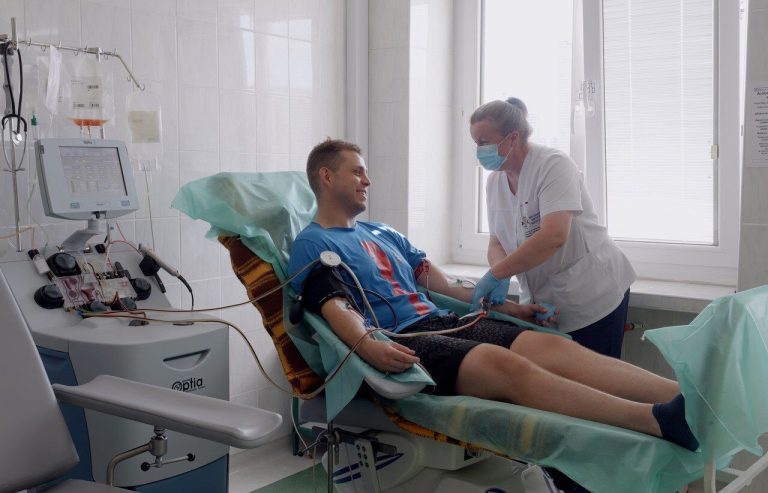Dog therapy – what is it, for whom and what are its goals? Dog breeds for dog therapy

Contact with animals has a positive impact on our well-being. Dog therapy is a form of therapy involving a dog. These animals perform various functions – they are not only pets, but also, among others: guide dogs and helpers, e.g. for blind people. In order for a dog to work as a companion animal or participate in therapeutic activities, it must be properly trained. We explain what dog therapy is, what its main goals are and which dog breeds are suitable for dog therapy.
- What is dog therapy?
- Who can benefit from dog therapy?
- Goals of dog therapy
- Forms of dog therapy
- Dog breeds for dog therapy
A dog is man’s best friend, which can be used to support treatment and rehabilitation, among others. people with disabilities. Dog therapy (kynotherapy) is one of the forms of therapy that is used as support in the treatment of many diseases. Dog therapy is a contact therapy that aims, among others, to: improving mood, physical fitness and general well-being. Close contact with a dog helps you relax and unwind and triggers positive emotions in children and adults. It is worth mentioning that dog therapy is used both to support the treatment of people with physical and intellectual disabilities. This form of therapy is used by, among others: people with cerebral palsy who suffer from limb paresis and people with developmental defects and mental disorders. Seniors also often benefit from dog therapy – dog classes are an important element of supporting treatment and rehabilitation, including: elderly people staying in nursing homes and geriatric wards. Other forms of therapy with animals include, for example, hippotherapy (contact with a horse) and felinotherapy (contact with a cat).
What is dog therapy?
Dog therapy is a form of therapy using a dog, which is used as a “tool” to achieve specific therapeutic goals. Contact with a dog is intended to trigger positive emotions, motivates action and helps build trust between the patient and the therapist. The scope of dog therapy is tailored to the individual needs of the patient. A dog can stimulate physical and mental activity, e.g. by playing, walking, training or caring for the animal. A dog can also help establish contact with other people, becoming a “connector” between participants in group activities. It is worth mentioning that during therapy, the dog supports its owner by following specific commands and encouraging the patient to work with the therapist. Due to the nature of therapy, dogs that have a gentle temperament are used when working with disabled and sick people. Before the dog starts participating in classes, it is properly trained. To participate in therapeutic activities, the dog’s guardian must also obtain appropriate qualifications – therapy with animals is conducted by, for example, psychologists and educators.
Dog therapy is a form of therapy using animals, which is used all over the world during the treatment, convalescence and rehabilitation of children and adults. This form of therapy can be used, among others: in hospitals, care and educational centers, senior homes and hospices. More and more often, dog therapy is one of the forms of therapy used in psychiatric wards and addiction treatment centers.
Who can benefit from dog therapy?
Dog therapy brings many benefits to patients of various age groups. This form of therapy increases the effectiveness of treatment and rehabilitation of people diagnosed with, among others:
-
Asperger’s syndrome,
-
down syndrome,
-
cerebral palsy,
-
autism,
-
attention deficit hyperactivity disorder (ADHD).
Properly trained dogs are also great as support for psychotherapy of adults with various mental disorders (e.g. depression, anxiety disorders and states), children and adolescents with learning difficulties and behavioral disorders, as well as emotional disorders.
The beneficial effect of contact with dogs has also been confirmed in the case of seniors suffering from various diseases (e.g. senile dementia).
Goals of dog therapy
Dog therapy, through exercises tailored to the patient’s needs, influences cognitive functions, facilitates communication with the environment, improves motor skills, motivates the development of independence and influences contacts with other people.
The main goals of dog therapy include:
-
improving visual perception,
-
improving auditory perception,
-
motor and psychomotor improvement of gross motor skills,
-
motor and psychomotor improvement of fine motor skills,
-
improving eye-hand coordination,
-
speech development,
-
improving concentration.
Depending on the patient’s health condition, specific exercises with the animal are performed during therapeutic work.
Forms of dog therapy
Delta Society distinguished two forms of dog therapy, namely:
- AAA (Animal Assisted Activity) – this form of classes with a dog provides motivational, recreational, therapeutic and educational support, including various types of activities with the assistance of a pet. It is a form of group therapy whose main goal is to trigger spontaneous interactions between patients and the animal. In Animal Assisted Activity dog therapy, great emphasis is placed on ensuring the pleasure of contact with the dog. In this case, there is no obligation to keep therapeutic documentation, and the goals are planned for the long term;
- AAT (Animal Assisted Therapy) – in this case, we are dealing with planned therapeutic activities that allow us to achieve the set goal. Specific therapeutic activities are planned taking into account the needs of a given patient. In Animal Assisted Therapy, the dog is an integral element of the therapeutic process. Classes can be held individually or in groups, their scope is determined by an agreed plan, and the course is documented. Maintaining documentation is intended, among others, to: analysis of the impact of dog therapy on the patient’s health.
The European Association ADEu defines the above forms of therapy with the participation of a dog slightly differently and distinguishes an additional form of dog therapy – AAE (Animal Assisted Education), which is aimed at increasing interest in education. This form of dog therapy is used, for example, in children with difficulties in learning to read and supports speech therapy.
The Polish Kynotherapeutic Society has introduced additional terminology that defines the forms of dog therapy, i.e.:
-
Meeting a dog (SP) – these are spontaneous activities aimed at building trust and establishing a positive relationship with your pet.
-
Education with a dog (EP) – individual or group classes aimed at improving children’s intellectual and cognitive abilities.
-
Therapy with a dog (TP) – classes are held in accordance with an exercise plan established by a specialist, the aim of which is to achieve specific results, e.g. motor and psychomotor improvement of gross motor skills. The exercises are selected by the rehabilitator or the attending physician. This form of dog therapy requires keeping reliable documentation to monitor progress in treatment.
Dog breeds for dog therapy
Not every dog is suitable for working with sick and disabled people. Dog breeds used for dog therapy must have a gentle temperament. The following people most often participate in therapeutic activities:
-
Labrador retrievers,
-
golden retrievers,
-
Bernese Mountain Dogs,
-
Cavalier King Charles Spaniels,
-
Samoyeds,
-
Poodles.
They are gentle dogs, friendly towards people, very patient and obedient to their owners. A dog that is to become a therapist must demonstrate certain characteristics. During dog therapy, purebred animals of documented origin are used, which have undergone appropriate training and passed an examination at the Polish Cynotherapeutic Society. Importantly, the exam is repeated every year and the dog that passes it receives an appropriate certificate.
Dog therapy is not conducted with dogs of dangerous breeds or, for example, emotionally unstable, fearful or hypersensitive dogs. Before a dog is allowed to perform therapeutic work, it must be properly prepared medically, mentally and hygienically.
To sum up, dog therapy is one of the most frequently used forms of therapy with animals, which provides many benefits and can be tailored to the individual needs of each patient. Dog therapy can be used by children and adults with various disabilities, diseases and disorders. Only dogs that meet the established criteria and have passed the examination at the Polish Cynotherapeutic Society are allowed to perform therapeutic work. The exam is repeated every year, and a dog that is to work with people requiring psychotherapy must be properly prepared, among others: medically. Importantly, therapeutic work is a challenge for the dog, so both the scope of exercises and the working time should be adapted to the dog’s psychophysical capabilities.
Sources:
-
Damian Jagielski, Agnieszka Jagielska, Anna Pyszora, Dog therapy – history, assumptions, goals. Proposed application in palliative care, Medycyna Palliatywna w Praktyce, 8 (4), pp. 163-167, 2014
-
Pawlik-Popielarska B., Dog-assisted therapy, Via Medica Publishing House, Gdańsk, 2005
-
Bartkiewicz W., Zawadka M., Dog – therapist and family friend: the role of the dog in the rehabilitation process of a disabled child, Publishing House Fundacja Pomocy Niepełnosprawnym “Wiedza”, Warsaw, 2008






